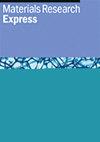利用改性活性碳超声波辅助去除废水中的甲基橙和牛血清白蛋白:RSM 优化和可重复使用性
IF 2.2
4区 材料科学
Q3 MATERIALS SCIENCE, MULTIDISCIPLINARY
引用次数: 0
摘要
去除水中的工业污染物仍然是水处理工艺中的一项重大挑战。本研究考察了粉末活性炭(PAC)、热改性 PAC(TPAC)和化学改性 PAC(CPAC)去除模拟废水中牛血清白蛋白(BSA)和甲基橙(MO)的效果。与原始 PAC 的初始表面积 619 m2 g-1 相比,经过处理后,TPAC 的 BET 表面积增至 823 m2 g-1,而 CPAC 的 BET 表面积增至 657 m2 g-1。在超声波辅助下进行了批量吸附实验,以评估溶液 pH 值、初始浓度和接触时间对 BSA 和 MO 吸附能力(qmax)的影响。与 PAC(qmax 值分别为 124 mg g-1 和 112 mg g-1)相比,TPAC 表现出更优越的性能,MO 和 BSA 的 qmax 值分别达到 152 mg g-1 和 133 mg g-1。此外,pH 值分别为 3 和 5 对去除水中的 MO 和 BSA 非常有效。在间歇和超声条件下,MO 和 BSA 的吸附动力学均遵循假 2 阶(R2 > 0.99)反应动力学,证实了污染物是通过化学吸附去除的。吸附趋势也符合 Langmuir 等温模型,表明这些污染物在吸附过程中形成了均匀的单层。为了解所有变量的同时影响,采用中心复合设计(CCD)的响应面方法(RSM)来预测 CPAC 的吸附容量。经过五个吸附循环后,CPAC 系统对 MO(从 98% 降至 80%)和 BSA(从 55% 降至 40%)的去除率均有所下降。结果表明,CPAC 可有效去除废水中的 MO。本文章由计算机程序翻译,如有差异,请以英文原文为准。
Ultrasonic assisted removal of methyl orange and bovine serum albumin from wastewater using modified activated carbons: RSM optimization and reusability
The removal of industrial pollutants from water remains a significant challenge in water treatment processes. This study investigated the efficacy of powder-activated carbon (PAC), thermally modified PAC (TPAC), and chemically modified PAC (CPAC) for removing bovine serum albumin (BSA) and methyl orange (MO) from simulated wastewater. After undergoing treatment, the BET surface area of TPAC increased to 823 m2 g−1, while that of CPAC increased to 657 m2 g−1 compared to the initial surface area of pristine PAC, which was 619 m2 g−1. Batch adsorption experiments assisted by ultrasonication were conducted to evaluate the impact of solution pH, initial concentration, and contact time on the adsorption capacities (qmax) of BSA and MO. TPAC demonstrated superior performance, achieving qmax values of 152 mg g−1 for MO and 133 mg g−1 for BSA, compared to PAC, which provided qmax values of 124 mg g−1 and 112 mg g−1, respectively. Furthermore, pH levels of 3 and 5 were identified as highly effective for the removal of MO and BSA from water, respectively. The adsorption kinetics of both MO and BSA followed pseudo2nd-order (R2 > 0.99) reaction kinetics under both batch and ultrasonic conditions, confirming the removal of contaminants through chemisorption. The adsorption trends also satisfied the Langmuir isothermal model, indicating the formation of a uniform monolayer during the adsorption process of these contaminants. To understand the simultaneous effect of all the variables, response surface methodology (RSM) using central composite design (CCD) was used to predict the adsorption capacities of CPAC. After five adsorption cycles, the removal efficiencies of MO (from 98% to 80%) and BSA (from 55% to 40%) decreased in the CPAC system. The results suggested that CPAC can be effectively utilized to remove MO from wastewater.
求助全文
通过发布文献求助,成功后即可免费获取论文全文。
去求助
来源期刊

Materials Research Express
MATERIALS SCIENCE, MULTIDISCIPLINARY-
CiteScore
4.50
自引率
4.30%
发文量
640
审稿时长
12 weeks
期刊介绍:
A broad, rapid peer-review journal publishing new experimental and theoretical research on the design, fabrication, properties and applications of all classes of materials.
 求助内容:
求助内容: 应助结果提醒方式:
应助结果提醒方式:


